PA Amphibian & Reptile Survey

For our 2014 Citizen Science project in Glen Providence Park, we are participating in the Pennsylvania Amphibian and Reptile Survey (PARS). Launched in 2013, PARS is a project to determine the distribution and status of all amphibians and reptiles (*”herps”) throughout Pennsylvania. PARS is a joint venture between the PA Fish & Boat Commission and the Mid-Atlantic Center for Herpetology and Conservation, and this project will provide them with valuable data for study and conservation.
According to PARS, very little information about Pennsylvania’s herps has been collected through the years when compared to other groups of organisms, yet herps are important indicators of the health of our natural places. A new study showed that woodland salamanders play a significant role in the global carbon cycle!
Our project:
We started by entering all of our photo-documented herp sightings in Glen Providence Park on the PARS database, with photos back to 2003. We made 143 entries for 2003 through 2013, and we are entering our 2014 sightings. You can view our records and sort them by species or date. The PARS website has a list of all species that can be found in PA.
To protect sensitive reptiles and amphibians, exact locations are only viewable by the PARS reviewers and the PA Fish & Boat Commission – entries are publicly listed by county only. We consulted with PARS, and decided to report our sightings of common species with the user name Friends of Glen Providence Park, but we anonymously report any sensitive species in the park (anything ranging from species of special concern to endangered species).
How you can help:
PARS needs volunteers, from skilled professional scientists to the most amateur naturalist. To participate, sign up on the PARS website, and start entering your sightings – anywhere in Pennsylvania! As the location will not be publicly shown, if you find a species in Glen Providence Park that is not already on our list, please email us with a link to your PARS entry – and we will add it to our species list.
Interested in learning more about herps? Visit the informative PARS website, and join us on our Herpetology Walk with Kyle Loucks on Saturday, August 9. Kyle is the South East Regional Coordinator for PARS, and the person who told us about this project!
See our species list and gallery below – click on any photo for a closer look!
*Herpetology is the study of amphibians and reptiles, and herps is slang for amphibians and reptiles.
Glen Providence Park
Amphibian & Reptile Species List
Excluding 2 sensitive species
as of 6-7-2014
Salamanders
Desmognathus fuscus – Northern Dusky Salamander
Eurycea bislineata – Northern Two-lined Salamander
Plethodon cinereus – Eastern Red-backed Salamander
Frogs & Toads
Anaxyrus americanus – Eastern American Toad
Lithobates catesbeianus – American Bullfrog
Lithobates clamitans – Green Frog
Lithobates palustris – Pickerel Frog
Lithobates sylvaticus – Wood Frog
Turtles
Trachemys scripta elegans – Red-eared Slider (invasive)
Chelydra serpentina – Snapping Turtle
Chrysemys picta – Painted Turtle
Sternotherus odoratus – Eastern Musk Turtle
Snakes
Nerodia sipedon – Northern Watersnake
Storeria dekayi – Northern Brownsnake
Thamnophis sirtalis – Eastern Gartersnake
- Northern Dusky Salamander
- Northern Two-lined Salamander
- Eastern Red-backed Salamander
- Eastern American Toads
- American Bullfrog
- Green Frog
- Pickerel Frog
- Wood Frog
- Red-eared Slider
- Snapping Turtle
- Painted Turtle
- Eastern Musk Turtle
- Northern Watersnake
- Northern Brownsnake
- Eastern Gartersnake
Thank you to Holly Hoffmann for the photo of the Northern Two-lined Salamander, and to Walt Cressler for the photo of the Northern Brownsnake. Remainder of photos by Stephanie Gaboriault.

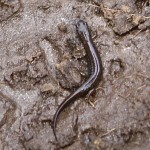
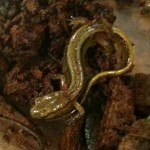
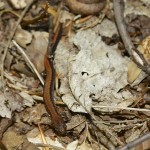
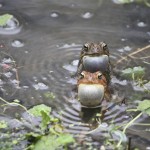

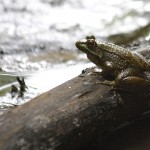
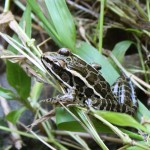
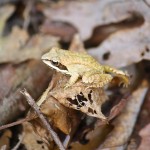
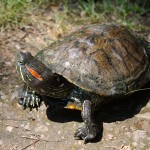


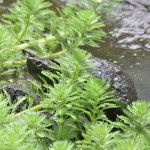
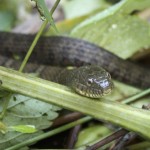
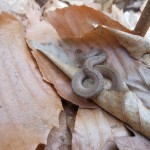
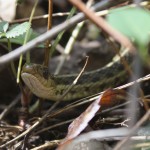








Inquiry: I live in paradise township, Monroe county. I have two ponds in my yard which have had many frogs all summer for the past 14 years. We do not use any chemicals outside or inside our house and are surrounded by woodland. This year we do not have even 1 frog, nor have we seen any egg masses other than a small one early this spring which was salamanders.
Going from dozens to absolutely no frogs in one season is startling. I have researched explanations of amphibian decline but I still find the suddenness of my own experience frightening. Has my experience been noted in other areas? Is there any possibility that the rubber (?) lining of the ponds is leaching something?
Also, there are almost no snakes to be seen and the red efts are absent.
Thank you, Pam Mading